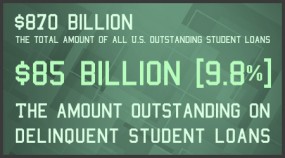 There is a lot of student loan debt out there, we’re constantly told. Many graduates can’t keep up with their student loan payments, even if they are lucky enough to have a job. And this, of course, leads to default.
There is a lot of student loan debt out there, we’re constantly told. Many graduates can’t keep up with their student loan payments, even if they are lucky enough to have a job. And this, of course, leads to default.
So we know there is a lot of student loan debt out there and a lot of it goes into default. But just how much is there, and more importantly, how much would potentially be available for members of the ARM industry?
 According to the Federal Reserve Bank of New York (FRBNY), at the end of the third quarter 2011, there was about $870 billion in outstanding student loan debt. That’s more than credit cards and more than auto loans. In fact, it’s more than any single asset class that is not backed by real estate (so basically, mortgages).
According to the Federal Reserve Bank of New York (FRBNY), at the end of the third quarter 2011, there was about $870 billion in outstanding student loan debt. That’s more than credit cards and more than auto loans. In fact, it’s more than any single asset class that is not backed by real estate (so basically, mortgages).
Of that $870 billion, about $85 billion is delinquent. Close to 10 percent!
At the peak of the credit crisis, when it seemed all asset classes had no ceiling for late payments, credit card delinquency rates hit 6.7 percent on aggregate, also according to the Federal Reserve. So a 10 percent delinquency rate is crazy.
Even crazier, the total pool of outstanding student loan debt includes loans that are currently in deferral. Student loans are different than most consumer loans in that the repayment period does not begin when the loan is originated. Instead, students begin paying their loans back after they graduate. And even then, there is often a six month grace period. While a student is in school, or during the grace period, the loan is said to be in deferral. Since no payments are being made, a delinquency is not possible.
 When the FRBNY excluded the loans that were in deferral, it found that a staggering 21 percent of the remaining outstanding student loan balance is delinquent. Not only that, 27 percent of all borrowers have at least one delinquent student loan account. That represents 5.4 million borrowers. So once a student graduates, he has a 1 in 4 chance of falling behind on his student loans.
When the FRBNY excluded the loans that were in deferral, it found that a staggering 21 percent of the remaining outstanding student loan balance is delinquent. Not only that, 27 percent of all borrowers have at least one delinquent student loan account. That represents 5.4 million borrowers. So once a student graduates, he has a 1 in 4 chance of falling behind on his student loans.
So there is a clearly a market here for the ARM industry. Let’s get specific on who can work what.
According to insideARM’s Local, State, and Federal Government Debt Collection Report, the federal government counted $230.2 billion in student loan receivables at the end of fiscal year 2010.
In September 2011, the Department of Education’s Default Division reported that its portfolio was sized at $33.5 billion. As luck would have it, ED’s report covered the exact same time period as the one from the FRBNY, so we can actually compare the two with no adjustments required.
ED’s Default Division is responsible for collecting all defaulted student loans that are backed by the U.S. government. Its $33.5 billion pool of bad student debt is off limits to any ARM company other than the 22 private collection agencies currently under contract and their subcontractors. But that still leaves some $51.5 billion in delinquent loans that are not under ED’s control.
ED’s default pool previously included loans originated by private lenders under the federally subsidized private loan program. But the Student Aid and Fiscal Responsibility Act, which got attached to the healthcare reform bill in 2010, changed that. Going forward, all student loans that would have been previously guaranteed by the government are going to be originated directly by the Department of Education.
But there are still plenty of private lenders participating in the student loan market. The Federal Direct Student Loan Program does not originate loans to pay for non-accredited or for-profit schools. They also only cover tuition and certain approved fees. In addition, many colleges and universities offer their own loans to students who need help filling the financial gaps left by the direct loan program. Mega-bank Chase, among others, also has a formal program to cover federal loan shortages. These are often the clients of student loan collectors not on ED’s collection contract.
And, of course, of the total delinquent loans, a certain percentage will rehabilitate without defaulting.
Regardless of the actual size, the student loan debt collection market can be measured in dozens of billions of dollars. And the market will only continue to grow in coming years.




![[Image by creator from ]](/media/images/patrick-lunsford.2e16d0ba.fill-500x500.jpg)


![Report cover reads One Conversation Multiple Channels AI-powered Multichannel Outreach from Skit.ai [Image by creator from ]](/media/images/Skit.ai_Landing_Page__Whitepaper_.max-80x80.png)
![Report cover reads Bad Debt Rising New ebook Finvi [Image by creator from ]](/media/images/Finvi_Bad_Debt_Rising_WP.max-80x80.png)
![Report cover reads Seizing the Opportunity in Uncertain Times: The Third-Party Collections Industry in 2023 by TransUnion, prepared by datos insights [Image by creator from ]](/media/images/TU_Survey_Report_12-23_Cover.max-80x80.png)
![[Image by creator from ]](/media/images/Skit_Banner_.max-80x80.jpg)
![Whitepaper cover reads: Navigating Collections Licensing: How to Reduce Financial, Legal, and Regulatory Exposure w/ Cornerstone company logo [Image by creator from ]](/media/images/Navigating_Collections_Licensing_How_to_Reduce.max-80x80.png)
![Whitepaper cover text reads: A New Kind of Collections Strategy: Empowering Lenders Amid a Shifting Economic Landscape [Image by creator from ]](/media/images/January_White_Paper_Cover_7-23.max-80x80.png)